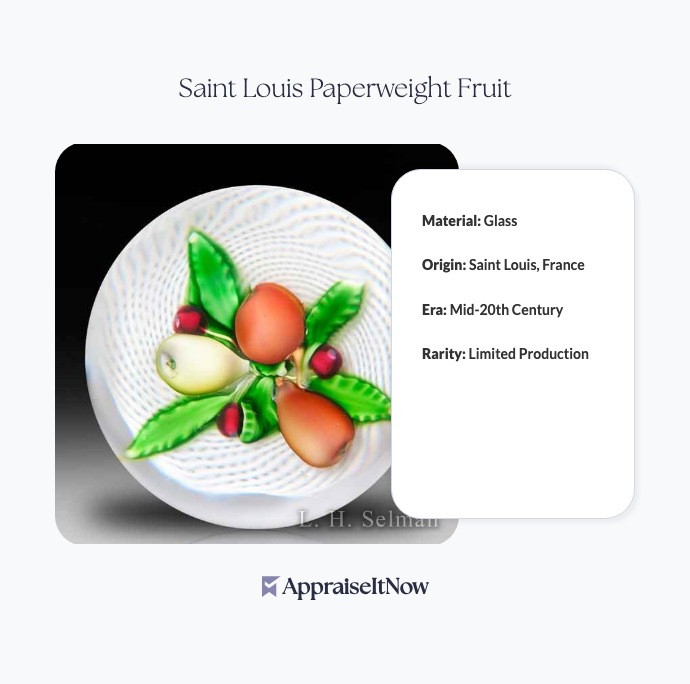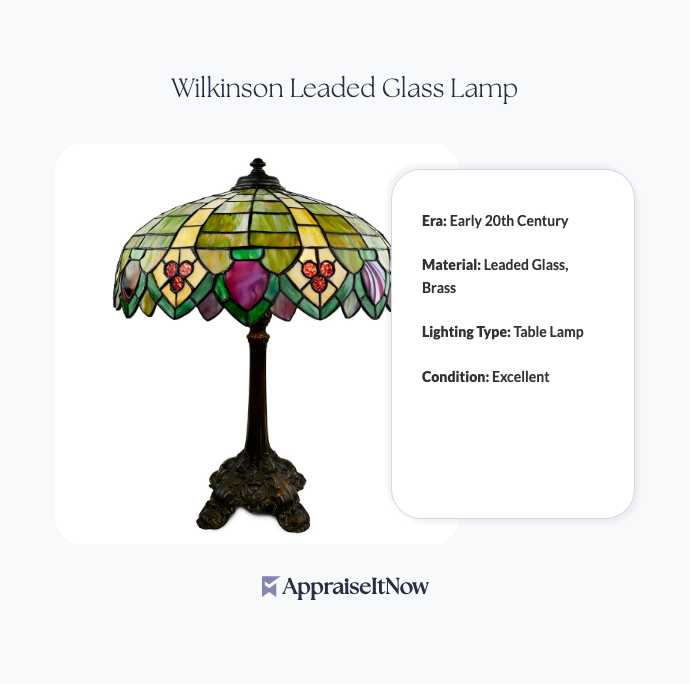<h1>How to Get Your Lalique Opalescent Glass Vase Appraised</h1>
<p>The Lalique Opalescent Glass Vase represents a pinnacle of French Art Nouveau craftsmanship, commanding market values between <strong>$1,800 and $3,200</strong> for examples in good condition. If you own one of these stunning pieces—whether inherited, discovered, or acquired—understanding how to properly appraise it ensures accurate valuation for insurance, sale, or collection documentation purposes.</p>
<h2>Understanding Lalique's Market Value and Significance</h2>
<p>René Lalique's opalescent glass vases occupy a unique position in the collectibles market, combining artistic merit with historical significance. Your vase likely features Lalique's signature manufacturing process, which creates that distinctive <strong>shimmering, pearlescent effect</strong> through specialized molding and finishing techniques. First introduced in <strong>1924</strong>, these pieces were produced in limited runs, making each example increasingly rare as decades pass.</p>
<p>The value of your Lalique vase stems from several converging factors. The piece's rarity, historical exhibition records, and exceptional craftsmanship make it highly sought by both individual collectors and museums. Many collectors ask themselves whether Lalique pieces increase in value—the answer is consistently yes. The opalescent glass market has demonstrated steady appreciation over the past two decades, with exceptional examples outpacing inflation significantly. When considering <a href="/blog/appraising-fine-glass-and-crystal-valuing-delicate-glassware-and-artistic-creations">fine glass and crystal appraisals</a>, professional valuators understand these market dynamics intimately.</p>
<div class="callout tip"><p><strong>Collector's Insight</strong></p>
<p>Lalique vases with documented exhibition history—particularly those displayed at the Paris Exposition—can command premiums of 25-40% above comparable pieces without such provenance.</p></div>
<h2>How Do You Know If Your Vase Is Actually Lalique?</h2>
<p>Authentication forms the foundation of any professional appraisal. A genuine Lalique opalescent glass vase carries specific identifying marks that distinguish it from reproductions or similar glassware. Collectors frequently wonder how to know if their vase is Lalique, and the answer involves examining several key indicators.</p>
<p><strong>What does a Lalique mark look like?</strong> Authentic pieces typically bear René Lalique's signature, either molded directly into the glass or etched on the underside. The mark usually reads "R. Lalique" or simply "Lalique," depending on production era. Your vase should also feature the characteristic opalescent finish—a milky, iridescent quality that shifts between white, pale blue, and amber tones depending on lighting conditions.</p>
<p>Beyond signatures, professional appraisers examine construction quality, the precision of molded details, and the weight of the glass. Lalique's process produced pieces with remarkable consistency in thickness and finish, qualities that distinguish genuine examples from later imitations. Many valuable Lalique pieces also feature <strong>18k gold accents</strong>, adding both visual appeal and material value to the piece.</p>
<div class="callout note"><p><strong>Authentication Detail</strong></p>
<p>Dating Lalique requires understanding production periods and mark evolution. Earlier pieces (1924-1945) typically show different signatures and manufacturing characteristics than post-war examples.</p></div>
<h2>What Determines Your Vase's Specific Value?</h2>
<p>The estimated $1,800-$3,200 range reflects market conditions for typical Lalique opalescent vases, but your specific piece may fall higher or lower based on several critical factors. Understanding these value drivers helps you prepare meaningful documentation for professional appraisers.</p>
<p><strong>Condition</strong> stands as the primary value determinant. Your vase's surface should show minimal damage—scratches, chips, or cloudiness significantly reduce value. Original finish integrity, meaning the opalescent coating remains undamaged and shows proper luster, directly correlates with appraisal price. Pieces requiring restoration typically lose 30-50% of their potential value.</p>
<p><strong>Production rarity</strong> matters considerably. Limited production runs mean fewer examples survive, increasing value for remaining pieces. The organic, elegant silhouette characteristic of Lalique's design language creates visual appeal that drives collector demand. If your vase features the distinctive Art Nouveau molded designs with nature-inspired themes—flowers, leaves, or abstract organic forms—you likely own a more desirable example.</p>
<p>Collectors also wonder whether specific Lalique marks hold special significance. <strong>What does a number on the bottom of a vase mean?</strong> These markings typically indicate production batch numbers or model designations, helping appraisers establish manufacturing dates and confirm authenticity. Your vase's provenance—its ownership history and documented exhibitions—significantly impacts valuation, particularly if it can be connected to notable collections or museum displays.</p>
<h2>The Role of Professional Appraisers in Establishing Value</h2>
<p>Whether you're seeking insurance coverage, planning an estate distribution, or considering a sale, professional appraisers provide essential expertise that individual research cannot replicate. An appraiser specializing in <a href="/types/antique-artwork">antique artwork</a> and decorative arts understands Lalique's position within broader art market trends, recent comparable sales data, and regional collector demand variations.</p>
<p>Finding qualified appraisers involves seeking credentials from recognized organizations like the <strong>American Society of Appraisers (ASA)</strong> or the <strong>International Society of Appraisers (ISA)</strong>. These professionals apply standardized methodologies and provide <strong>USPAP-compliant reports</strong> suitable for insurance companies, legal proceedings, or financial institutions. When evaluating appraisers, ensure they have specific experience with <a href="/blog/how-to-accurately-determine-the-value-of-your-memorabilia-and-collectibles">decorative arts and collectibles valuation</a>, as general appraisers may lack the specialized knowledge required for accurate Lalique assessment.</p>
<h2>Are Lalique Vases Worth Collecting?</h2>
<p>This question reflects broader collecting motivations that appraisers often encounter. The answer depends on your perspective. From an investment standpoint, Lalique pieces have demonstrated consistent appreciation, outperforming many alternative collectibles over 20-30 year periods. The finite supply—no new production occurs—combined with growing collector demand creates favorable market conditions.</p>
<p>Beyond financial considerations, Lalique represents the pinnacle of early 20th-century decorative arts. Owning a piece means possessing tangible art history, a connection to René Lalique's genius and the broader Art Nouveau movement. For collectors prioritizing cultural and aesthetic value over pure financial return, Lalique pieces offer exceptional satisfaction.</p>
<p>The market shows particular strength in opalescent examples like your vase. These pieces appeal to both serious collectors pursuing comprehensive Lalique collections and casual collectors seeking a single stunning decorative object. Museums actively acquire exceptional Lalique pieces when they become available, indicating institutional recognition of lasting significance and value.</p>
<h2>Documentation and Preparation for Appraisal</h2>
<p>Before scheduling a professional appraisal, compile relevant information about your Lalique vase. Gather any documentation regarding its acquisition—purchase receipts, auction catalogs, family records, or exhibition materials. Photograph your vase comprehensively: overall views from multiple angles, close-ups of markings and signatures, and detailed shots revealing condition, finish quality, and design elements.</p>
<p>Measure your vase's dimensions precisely, as size affects valuation for certain forms. Note the exact appearance of any markings, including how signatures are rendered (molded versus etched). Document any previous restoration or repairs, as these significantly influence appraisal values. This preparatory work expedites the appraisal process and ensures appraisers have complete information for accurate valuation.</p>
<div class="callout tip"><p><strong>Documentation Tip</strong></p>
<p>Maintain detailed records of your vase's condition over time. Periodic professional photography establishes a baseline, protecting your interests should damage occur or value disputes arise.</p></div>
<h2>Where to Sell or Insure Your Lalique Vase</h2>
<p>Understanding where to sell Lalique glass informs your appraisal strategy. Collectors ask where the best place to sell Lalique resides, and the answer varies based on your piece's specific characteristics and your priorities. Auction houses specializing in decorative arts—Christie's, Sotheby's, and reputable regional houses—provide broad exposure to qualified buyers. Their pre-sale estimates, based on expert appraisals, help establish realistic expectations.</p>
<p>Private sales through galleries or dealers specializing in Art Nouveau decorative arts often yield higher realized prices than auction results, though sales timelines extend considerably. Online platforms and private collector networks represent alternative channels, though they require your own documentation and marketing efforts. Professional <a href="/blog/appraising-personal-property-for-purchase-and-sale">personal property appraisals</a> provide the certified valuations these venues require.</p>
<p>For insurance purposes, work with providers specializing in fine arts and collectibles. Your certified appraisal establishes agreed-upon value, ensuring replacement coverage at current market rates. This documentation protects your investment against loss, damage, or theft—critical considerations for items valued at several thousand dollars.</p>
<h2>How Much Your Specific Vase Is Worth</h2>
<p>Determining exact value requires professional assessment, but you can develop realistic expectations using market research. Recent comparable sales of similar Lalique opalescent vases indicate current demand. Search auction results for Lalique pieces with similar characteristics—size, design motifs, condition, and production era—to establish benchmarks.</p>
<p>Consider your vase's position within the $1,800-$3,200 estimated range. Exceptional examples—those with museum exhibition history, pristine condition, rare design features, or significant size—occupy the range's upper reaches or exceed it entirely. Typical examples in good condition generally fall toward the middle range. Pieces showing wear, requiring restoration, or lacking strong provenance documentation approach the lower range.</p>
<div class="callout note"><p><strong>Key Takeaway</strong></p>
<p>Your Lalique Opalescent Glass Vase represents a significant decorative arts asset requiring professional appraisal for accurate valuation. Whether pursuing insurance coverage, planning estate distribution, or considering a sale, a certified appraiser provides the expertise, documentation, and market knowledge necessary to establish fair market value and protect your investment. <strong>AppraiseItNow</strong> connects you with credentialed appraisers specializing in fine glass and decorative arts, ensuring your valuable piece receives the professional assessment it deserves.</p></div>







.avif)







